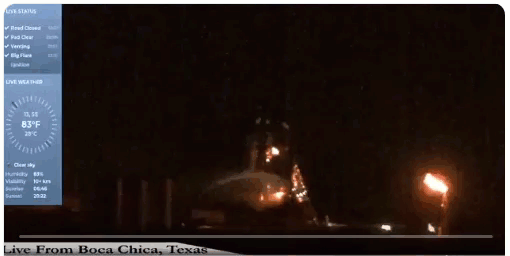
A SpaceX rocket test at their beach-front Texas spaceport started brush fires that spread over the next 12 hours into the Las Palomas Wildlife Management Refuge. This incident follows two extremely large unplanned fires during earlier tests in the past 10 days. In the first incident, a huge fireball flew out of the rocket’s bottom. Then, just as the test began on June 25, massive flames poured out of the rocket. The attached video shows an explosive fire then another flame bursting out of the top of the rocket. Those fires were contained to the immediate launch pad area.

The fire during late Thursday’s test wasn’t contained on site. As Business Insider reports, “flaming debris spread by Starhopper's powerful rocket engine almost immediately started brush fires near the launch pad.” The fire had grown to more than 100 acres by the time of the story and had spread to the adjacent Refuge.
A home-owner who lives about two miles away pointed out that the fire had spread into the marshlands. But the Environmental Impact Statement for SpaceX's launch site plans, which the Federal Aviation Administration signed off on in July 2014, downplayed the risk of brush fires caused by rocket launches in the area.
"Launch activities would have minimal impacts to vegetation from potential fire. Fires are unlikely since launch activities would occur over concrete pads with no surrounding vegetation," claimed the Final EIS.
That’s the view from an office in Washington, DC.
It’s best to read the whole story from the source: https://www.businessinsider.com/spacex-starhopper-rocket-launch-wildfires-texas-2019-7
Spaceport Camden opponents have warned since 2015 of the fire risk on spaceport property, and to Cumberland and little Cumberland Islands. Neither the FAA nor SpaceX thought a fire was possible on a beach-front spaceport like Boca Chica. Imagine how large the 100-acre fire could grow on our remote islands that have few roads.
Spaceport Camden considers the adjacent salt marshes a “buffer” for the spaceport. The marshes are valuable natural resources that belong to the State of Georgia and are not Camden's to sacrifice as a "buffer" for risky spaceport activity. Interstate 95 was shut down for a day last month near the Yulee exit because a wildfire spread into the marshes. In Texas, SpaceX lit adjacent salt marshes ablaze with a rocket test.
The reason the fire spread is because of the area's mucky ground conditions, said Bryan Winton, manager of the Lower Rio Grande Valley national wildlife refuge at the US Fish and Wildlife Service (FWS). Winton said fire trucks can't easily get close to the flames. That's exactly the problem in Camden County. There are two small fire trucks on Cumberland that has single-lane dirt roads and 10,000 acres where no mechanized equipment can travel. There are no roads that can host a fire truck on Little Cumberland. Camden taxpayers will pay for extra fire protection needed on the spaceport property.
Spaceport Camden is hundreds of times riskier than SpaceX Texas where the nearest downrange populations are 800 miles away. The potential damage to historic places and private homes is real, and humans will be at risk from Spaceport Camden. The FAA intentionally does not study worst case accidents. In Texas, they didn't even think a brush fire from a single-engine rocket was likely.
The FAA and Camden’s consultants haven't seemed to take the risk of fire seriously. It was only in February 2019 that the FAA asked Camden for more information on “mitigation on the potential risk for fire.” That’s after opponents raised the problem during the 2016 Scoping period and 2018 Draft EIS Comment period, plus in numerous private entreaties to the FAA. Anyone who thinks the FAA puts public safety first hasn't been paying attention.
Spaceport Camden presents safety, fiscal, and environmental risks that cannot be justified any more than would plans for another pesticide plant on that property. Are our Commissioners willing to accept a speculative spaceport no matter the costs or risk with little assurance of any benefit to citizens?